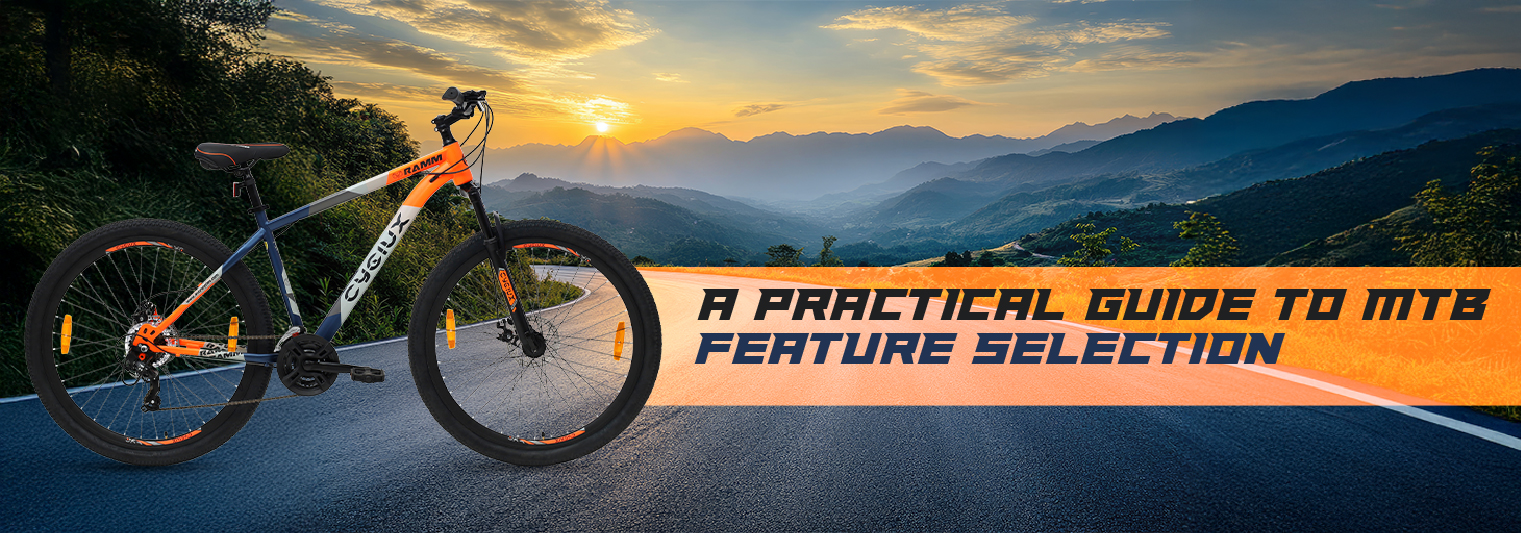 2025-07-08
2025-07-08
5 Read
Trail conditions shape the kind of cycle that fits best. Each component, from suspension to frame geometry, affects how the cycle handles pressure, slope and surface changes. Some builds prioritise speed and agility, while others focus on traction and impact control. The ideal setup depends on terrain type, frequency of use and the demands of the ride itself.
The frame acts as the backbone of a mountain cycle. It affects both how much weight the cycle carries and how well it absorbs stress. Aluminium is widely used due to its balance of strength and low weight, helping the cycle respond quickly without dragging on inclines. Steel adds more mass but brings added toughness and shock resistance, especially helpful on rocky stretches or steep declines. The angle and shape of the frame also play a role. A sloped head tube offers stability on downhill routes, while a steeper design supports sharper turns and uphill control.
Every trail brings its own rhythm. Some roll smooth with the occasional dip, while others are scattered with roots, stones and sudden drops. The right suspension helps absorb that rhythm, smoothing out the harsh edges.
No-suspension frames keep things simple. Fewer parts, less fuss. Best suited to flatter trails and solid paths. Hardtail frames add front suspension, softening the force from uneven ground and giving tyres more contact when needed most. A practical middle ground.
Full-suspension designs spread out the support. Front and rear sections move with the terrain, keeping balance steady on more technical routes. More comfort, more control, especially when the path stops playing nice. The setup depends on the surface. Lighter trails ask for speed and ease. Rougher tracks call for more cushioning. The build should meet the land.
Gear Options and Drivetrain Layout
The transmission system controls how efficiently a cycle manages changes in slope and speed. Multi-speed models allow smoother transitions across varying terrain, offering more control during climbs, flats and descents. Avon Cycles provides geared MTB models that suit a wide range of conditions. For those seeking a simplified setup, MTB single-speed cycles eliminate gear adjustments entirely. These models work well on flatter tracks or as tools for building strength, with fewer moving parts to maintain and a direct, consistent ride feel.
Wheel Dimensions and Tyre Profiles
Different trails ask for different tools. A tighter bend or quick turn calls for a wheel that reacts fast. A longer stretch with dips and climbs needs something that holds steady and keeps moving. Smaller wheels bring sharp handling and fast starts. Mid-size options balance control with roll. Larger wheels smooth out rough patches and carry speed with less effort. Tyres follow the same logic. Thick treads bite into loose ground and mud. Slimmer ones glide over firm paths. Grip or glide, it all comes down to the kind of ride ahead.
Braking Setup
Braking power must remain reliable regardless of trail conditions. Mechanical disc brakes are widely used and function well in dry or wet weather. For stronger and more consistent stopping force, especially on steep or slick paths, hydraulic disc systems offer a clear upgrade. Their precision and lower input effort help reduce fatigue on longer trails or downhill sections.
Sizing and Proportions
Correct frame sizing ensures a balanced and secure experience. A frame that fits poorly can compromise control and cause discomfort. Measurements such as standover height, reach and saddle position all contribute to proper alignment. Selecting a cycle with the right frame size results in smoother handling, reduced strain and a more confident feel during technical segments.
Handlebars and Seating
Wider handlebars improve balance and precision, especially during descents. Flat bars or riser bars are common in mountain cycles depending on rider posture and preference. Saddle design impacts long-term comfort. Most mountain cycle saddles are narrow and firm to allow free movement on climbs or shifts in body weight. Adjustable seat posts are useful for different trail sections.
Weight and Portability
Weight plays a role in performance and practicality. Lighter bikes climb better and are easier to transport. Heavier bikes may include stronger parts and thicker tyres for trail durability. It helps to choose a balance between sturdiness and ease of use depending on terrain and riding frequency.
Durability and Component Quality
Mountain bikes take on water, dirt, rocks and rough conditions. Durable components reduce breakdowns and increase service intervals. High-quality chains, gears, pedals and bearings support long-term use. Avon Cycles builds MTB cycle models that meet these demands with reliable construction and attention to trail-specific needs.
Style and Intended Use
Style is more than surface detail. Paint finish, colour, and frame shape reflect personality and purpose. Some go for all-black builds, while others prefer bright colours. Intended use also matters. Fitness rides, off-road racing or weekend trail sessions all call for different features. Matching the model to the purpose leads to better overall value.
Final Gear Check
Before making the final call, check a few essentials. Are the tyres suited for the terrain? Is the gear range wide enough? Do the brakes respond well? Is the seat comfortable and easy to adjust? These checks help avoid surprises once the ride begins.
On the Trail Ahead
Choosing the right mountain cycle is not about picking the most expensive or feature-loaded option. It is about aligning the machine with the path, the rider and the purpose. Each trail offers a different rhythm. The best mountain bike cycle supports that rhythm with control, comfort and confidence. With the right setup, every ride opens the way for new trails, new challenges and stronger legs by the mile.